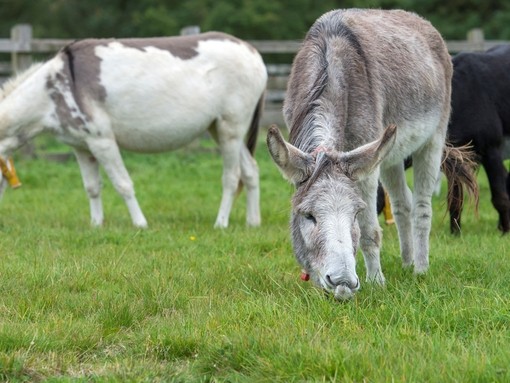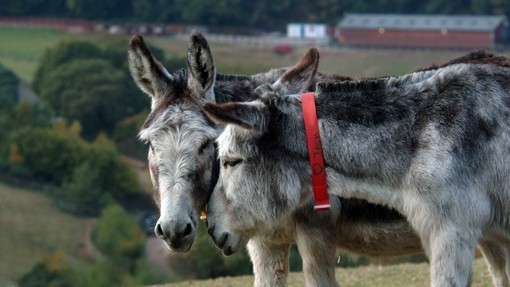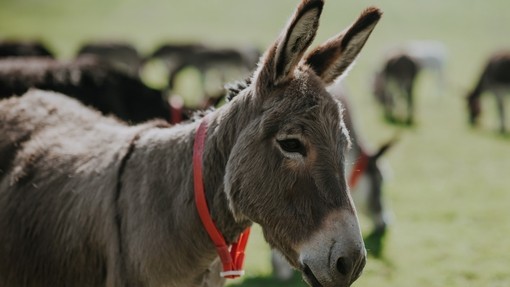
How can donkeys differ?
Donkeys today come in all shapes, sizes, colours and coat texture. The most common coat colour is grey, followed by brown and then black, roan and broken coloured donkeys (a combination of brown and white or black and white markings) and the rarest colour is pure white.
Glossary of donkey terms
Asino: An asino is the Italian word for “donkey”.
Ass: An ass is either a male or female donkey.
Burro: A burro is the Spanish word for “donkey”.
Colt: A colt is a young male donkey which is less than four years of age.
Filly: A filly is a young female donkey which is less than four years of age.
Foal: A foal is a baby male or female donkey up to one year old.
Gelding: A castrated male donkey.
Hinny: A hinny is the result of breeding between a female donkey and a male horse.
Jack: A jack is a term for a male donkey.
Jenny: A jenny (or jennet) is a term for a female donkey.
Mare: A female donkey.
Moke: A moke is a British term for a donkey.
Molly: A molly is a term for a female mule.
Mule: A mule is the result of breeding between a male donkey and a female horse.
Rig: A rig is an entire male donkey with no signs of external testicles.
Stallion: A stallion is a male donkey that has not been gelded (castrated).
Yearling: A yearling is a young male or female donkey between one and two years of age.
History of the donkey
Although millions of years ago donkeys and horses had the same ancestors they have evolved to be very different species and understanding those differences are of vital importance to the care and welfare of donkeys. There are two distinct species of wild donkey; the Asiatic branch of the species came from an area stretching from the Red Sea to Northern India and Tibet where the ass had to adapt to different climate, terrain and altitude. Consequently there is more than one type of Asiatic wild ass. The African branch of the species was found in North Africa between the Mediterranean coast and the Sahara Desert to the south of the Red Sea. There were two separate species of the African ass: the Nubian wild ass and the Somali wild ass. Our modern domesticated donkeys are all descended from these African wild asses ancestors.
Donkeys were first domesticated around 6,000 years ago in North Africa and Egypt for meat and milk. Around 2,000 years ago donkeys were among the draught animals used to carry silk from the Pacific Ocean to the Mediterranean along the Silk Road in return for trade goods. The overland route was approximately 4,000 miles or 6,400km and lasted several years. No single animal completed the entire journey and mixing of breeds occurred as unplanned matings happened en-route to give us the beginnings of the diverse range of donkey breeds we now have. The journey ended in the Mediterranean ports of Greece, Italy, the Middle East and Alexandria in Egypt. In Greece donkeys were found to be ideal animals for working on the narrow paths between the vines. Their use for cultivation in vineyards spread through the Mediterranean countries to Spain, whose coast at the southern tip is separated from North Africa by only a few miles - possibly another entry route for the African wild ass.
The Roman Army was responsible for the movement of donkeys into Northern Europe. Donkeys were used in agriculture and as pack animals. The Romans used donkeys in their new vineyards, some planted as far north as France and Germany. Donkeys came to England with the Roman invasion of Britain in AD 43. However, donkeys were still not commonly documented in the UK until after the 1550s. After the mid-17th Century, Oliver Cromwell’s invasion of Ireland saw an influx of donkeys being used to bear the labours of war. Following this, large numbers of donkeys were introduced to the country for the first time - opening opportunities for poorer and agricultural Irish communities to keep a cheap, working draft animal.

Donkey Questions and Answers
Yes, donkeys are very intelligent! They have a good memory and excellent ability to learn. In fact, according to a study released in 2013, we found out that donkeys in some situations can learn and problem-solve as quickly as dogs and dolphins. The more things a donkey learns, the faster they get at learning things in the future. Donkeys also remember both good and bad experiences for a long time and can even remember people’s faces if they’re in contact with them for a lengthy period. All donkeys are individuals, and some have better learning abilities than others due to their characters.
No, donkeys aren’t colourblind – but they do have different vision than us humans. Donkeys, like all equines, are ‘dichromatic’, meaning they have a two-colour vision. It is likely that donkeys can see blue and green but cannot distinguish red. This means that a juicy red apple would look green to a donkey, but just as delicious!
No, they are completely separate species! Millions of years ago, donkeys and horses had the same ancestors, but they have evolved to become very different species throughout that time. Although some donkeys and horses may look alike, donkeys have different physical, mental and emotional characteristics. They even have a different number of chromosomes. A noticeable difference between a horse and donkey is the call they make – horses make a high-pitched whinny while donkeys have a deep, throaty bray. Hee-haw!
Yes, donkeys are affectionate animals. However, it is important to understand that every donkey has its own personality. They especially enjoy the company of their own kind and can even form friendships with other equines like horses and mules when there are no other donkeys around. Donkeys usually form very strong bonds with their companions and can become ill if separated from them. Therefore, it is important to make sure they always have their friends around them, even if they travel somewhere outside their home. Reading the donkey’s body language is also a key skill to learn. Donkeys are very stoic animals, and their body language is less expressive than horses. Getting to know donkeys and understanding their body movement is a useful skill and benefits them too!
Yes, they do! Donkeys snooze standing up, and when they’re in a deep sleep, you’ll find them lying down on the floor. Did you know that donkeys sleep for short periods throughout each 24 hours and usually only sleep for a maximum of five hours a day? Because they are known as a ‘prey animal’ – susceptible to predators in the wild, donkeys are naturally very aware of their surroundings. Sleeping for long periods of time would make them more vulnerable to being predated on.
Yes, sometimes they do. While donkeys do not need shoes in the same way that many horses do, they have hooves that can become susceptible to nasty medical conditions, such as laminitis. This cripplingly painful foot disease can be brought on by eating too much rich grass or by an infection. Laminitis affects the tissues, also called laminae, which bonds the hoof walk to the pedal bone in the donkey’s hoof. It can make the pedal bone sink or rotate in the hoof, causing the donkey lots of discomfort and pain. We treat laminitis in several ways, one of which is by using a special shoe with gel inserts. This makes the donkey more comfortable on its feet while they recover.
Yes, all donkeys need access to a warm and dry shelter. Although they are hardy animals, donkeys can still be affected by the weather – they can get too hot or too cold. Contrary to popular belief, donkey’s coats aren’t waterproof as they don’t contain a natural build-up of grease like horse coats do. This means they can become soaked to the bone in heavy rain, especially if they don’t have a dry, safe shelter to hide in. All shelters should contain soft, clean bedding and access to clean drinking water and straw.
Yes, donkeys love fruit – but it should be fed to them in moderation! They are a worthwhile addition to the normal food ration in winter and early spring when fresh grass is not available. Avoid feeding potatoes, anything from the brassica family, onions, leeks, garlic, stoned fruit, and anything old, fermented, or mouldy as these are toxic to donkeys. Carrots, apples, bananas, pears, turnips and swedes are all safe and usually very popular with donkeys. Ensure that chopped fruit and vegetables are cut in a way that minimises choking risk, such as in sticks.
In the wild, male donkeys bray as a territorial display and for communication to distant females. In domestication, both male and female donkeys bray for various reasons. Braying can be from excitement, anticipation, loneliness, territorial response, boredom and healthy communication between donkeys. The bray is one of six vocal sounds a donkey makes. Each donkey’s bray is unique and can be heard over long distances. When a donkey learns braying is effective at getting human attention or food, it can become a learned behaviour.
The answer is millions, more than 50 million in fact! However, the number of pure-bred animals within each breed is low, and several breeds are actually on the verge of extinction. There are 17 breeds of donkeys currently known in Europe, and these range from the personality-packed Miniature donkeys, hailing from Italy, and the grand, imposing Poitou donkeys, which originate from France.
From Africa donkeys have spread worldwide, with an estimated world population of more than 44 million donkeys and 15 million mules and hinnies. Half the world’s donkey population, almost all of which is used for work, is found in Asia, just over one quarter in Africa, and the rest mainly in Latin America.
Donkeys today come in a variety of sizes and colours, with 186 separate breeds being recognised worldwide. The most common coat colour is grey, followed by brown and then black, roan and broken colour — a combination of brown-and-white or black-and-white markings. The rarest colour is pure white.
Donkeys come in a variety of fascinating shapes and sizes. We measure donkeys’ height in hands. Donkeys vary in size, with height at the withers ranging from 7.3 hands (79 cm or 31 inches) in the miniature, to Poitou donkeys measuring up to 15.3 hands (160 cm or 63 inches). Adult donkeys can weigh from 80 to 480 kg (180 to 1,060 lbs).
Share this page
Tags
- Blog




